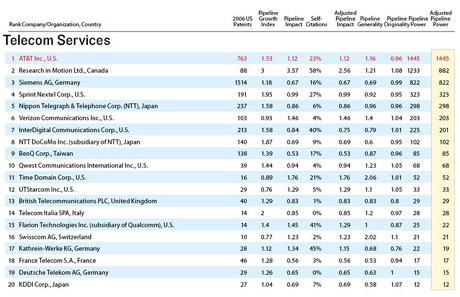IEEE survey cites AT&T, Microsoft and Cisco as top tech innovators

Although debates will never be completely settled about which technology companies research and introduce the most innovations, IEEE Spectrum has attempted to quantify this information.
The monthly publication of the IEEE (formerly known as the Institute of Electrical and Electronics Engineers, Inc.) uses a grading system based on granted patents to quantify innovative companies.
Before I present the results of three relevant fields, it would be useful to review the IEEE's stated methodology in this endeavor.
The number for 2006 U.S. Patents is a proxy for relative patent prowess worldwide. The Pipeline Power score is derived by multiplying the company’s patent count by the product of four other variables.
Bold face is mine.
Pipeline Growth (not shown here) represents the firm’s 2006 patent activity, relative to its average performance in the five previous years.
For the other three variables, a score above 1.00 indicates that the company performed better than average in its technology class; below 1.00 indicates worse than average performance. Pipeline Impact indicates how frequently all 2006 patents cited a company’s patents from the previous five years. Pipeline Generality is a measure of the variety of technologies drawing on a company’s patents. Pipeline Originality measures the variety of the technologies upon which an organization’s patents build. Adjusted Pipeline Impact eliminates self-citation. The final score, Adjusted Pipeline Power, is an estimate of a company’s overall patent power.
OK, got that? Now let us see what the IEEE's number crunching found:
No surprises in Telecom Services. AT&T has been a research leader for decades. And BlackBerry-maker's first name is "Research." Siemens is a cell research leader, so the three sound about right to me.
Microsoft, IBM and HP are the leaders in Computer Systems and Software research. No surprises there.
Telecom equipment. No surprises here either. Cisco and subsidiaries handle the infrastructure for most of the Internet, but for the last several years have branched out into networking and communications devices. Motorola, with their wide palette of communications gear, and Nokia, with their mobile device innovation, run second and third.
Of course if you are one of those readers who think that all patents must die, then you might not be in tune with these results.
